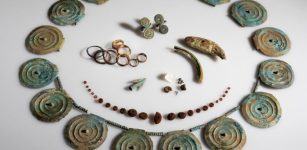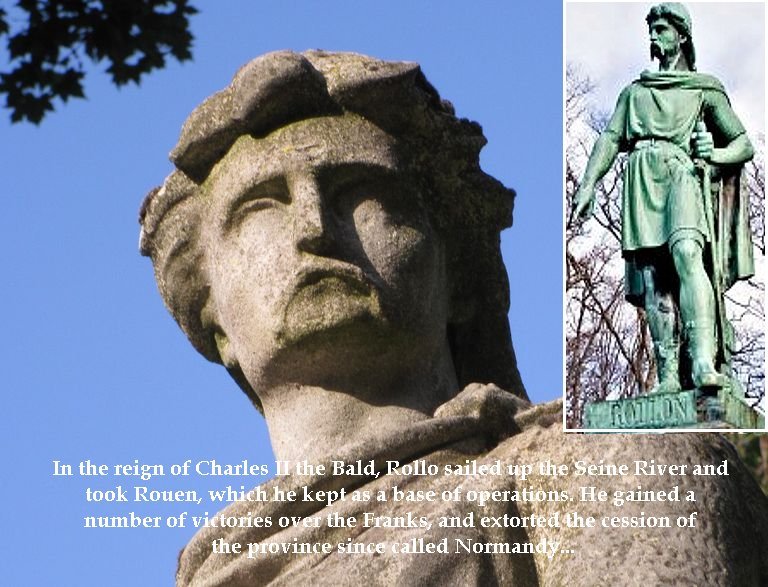Female Viking Pirate Rusla – The Red Maiden’s Deadly Encounter With Her Brother Tesondus
Ellen Lloyd - AncientPages.com - Brothers and sisters can love or hate each other. Siblings can also be rivals, which was by no means uncommon in the ancient world. Sometimes, encounters between a brother and a sister were deadly, like in the case of the Viking siblings Rusla and Tesondus.
Viking pirate Rusla made a huge mistake that led to her death.
The story of Rusla, sometimes called the Red Maiden and her brother Tesondus can be found in book eight of Gesta Danorum.
Gesta Danorum is a comprehensive and precious ancient manuscript that deals with the history of Medieval Denmark. Written in the 13th century by Saxo Grammaticus ("Saxo the Literate", literally "the Grammarian"), the manuscript consists of 16 books. The first nine books deal with Norse mythology and semi-legendary Danish history. The books 10-16 focus on Medieval history.
Rusla Becomes A Viking Pirate
There is some confusion about Rusla and her historical background is not entirely clear. She is sometimes referred to as Rusila, a Viking maiden who together with her sister Stekla fought King Olaf of Denmark.
Piecing together Rusla’s life story is not easy because the authors of ancient texts occasionally mixed events and people, but there it is nevertheless possible to get a historical overview of Rusla’s achievements and fate.
Rusla was said to be the daughter of Rieg, a Norwegian king who sometime between the fifth and sixth century ruled over Telemark, the region that borders Vestfold, Buskerud, Hordaland, Rogaland, and Aust-Agder.
She came in conflict with her brother Tesondus who was dispossessed of his throne by a Danish king named Omund. Rusla could not watch as her beloved country was taken over by the Danish rule and she was annoyed with her brother who didn’t care about the loss of his throne. So, she decided to become a pirate and officially announced war on her people who had declared allegiance to the Danes.
The longships gave the Vikings several advantages when they went to war or raids. Credit: Nejron Photo - Adobe Stock
Female Viking pirates are not unheard of. As Ancient Pages previously wrote, dressed as a man, Alwilda, a once imprisoned Viking princess, turned to piracy. She became a successful and feared leader.
Needless to say, King Omund disapproved of Rusla’s actions and decided to stop her. The Danish king sent some of his best soldiers to end her rebellion. However, this failed as the strong-willed and courageous warrior Rusla destroyed the Danish contingent.
Rusla Makes A Fatal Mistake
History shows Rusla became overconfident and too ambitious. She overestimated her power and she made a horrible mistake.
After her victory of the Danes, Rusla got an idea. As Laura Duncombe Sook writes in her book, Pirate Women, Rusla thought “why not aim a bit higher than independence from the Danish? Why not take over Denmark and rule both nations herself instead?
Fortune turned her back on Rusla, whose invasion of Denmark did not go well, forcing her to turn tail and run to save herself and her troops.“
Now, Rusla had a choice and she made the wrong decision.
“As she retreated from the Danes, she ran into her brother, whom she overpowered in short order, stripping him of all his ships and troops but refusing to kill Tesondus himself; that decision would prove to be her fatal mistake.
King Omund sent his fleet to Norway to attack Rusla’s fleet, and again she was defeated by the Danish forces. As she retreated for a second time, her brother Tesondus attacked and killed her. Some stories claim that he beat her to death with oars. For taking care of Rusla for him, Omund gave former rival Tesondus a governorship.” 1
Was Rusla Actually Rollo, The Viking Chieftain?
As mentioned earlier, the true identity of Rusla is a bit of a historical mystery. One of the most controversial theories comes from Professor Sophus Bugge, who suggests Rusla was not a woman but a man.
Credit: AncientPages.com
Tracing the origin of the Norse name, Professor Bugge concludes that Rusla was actually Rollo, the Viking sea lord, chieftain and the first ruler of Normandy, whose Anglo-Saxon name was Rodla. Because of the ending this name has been taken as a feminine, and the Irish have transformed the celebrated hero into a heroine." 2
It is fair to say that Rusla remains a very interesting personality in the history of the Vikings.
Written by Ellen Lloyd – AncientPages.com
Updated on July 31, 2021
Copyright © AncientPages.com All rights reserved. This material may not be published, broadcast, rewritten or redistributed in whole or part without the express written permission of AncientPages.com
Expand for references- Duncombe, Laura Sook. Pirate Women: The Princesses, Prostitutes, and Privateers Who Ruled the Seven Seas
- Bugge, Alexander - On the Fomorians and the Norsemen
More From Ancient Pages
-
 Treasure Trove Of Spices Found On The Sunken Medieval Ship Gribshunden
Archaeology | Feb 11, 2023
Treasure Trove Of Spices Found On The Sunken Medieval Ship Gribshunden
Archaeology | Feb 11, 2023 -
 Hydra Greek Monster: Fearsome Multi-Headed Dragon That Inhabited Swamps Of Lerna
Featured Stories | Sep 20, 2019
Hydra Greek Monster: Fearsome Multi-Headed Dragon That Inhabited Swamps Of Lerna
Featured Stories | Sep 20, 2019 -
 Slaves In The Aztec Empire Had Much Better Rights Than In Any Other Ancient Society
Ancient History Facts | Jul 6, 2016
Slaves In The Aztec Empire Had Much Better Rights Than In Any Other Ancient Society
Ancient History Facts | Jul 6, 2016 -
 Ancient Inscriptions Of Babylonian King Nabonidus Discovered In Saudi Arabia
Archaeology | Jul 14, 2021
Ancient Inscriptions Of Babylonian King Nabonidus Discovered In Saudi Arabia
Archaeology | Jul 14, 2021 -
 Extraordinary Bronze Age Jewelry Hoard Discovered In A Carrot Field In Switzerland
Archaeology | Oct 18, 2023
Extraordinary Bronze Age Jewelry Hoard Discovered In A Carrot Field In Switzerland
Archaeology | Oct 18, 2023 -
 Petronella Oortman And Her Giant Dolls’ House
Featured Stories | Jul 10, 2019
Petronella Oortman And Her Giant Dolls’ House
Featured Stories | Jul 10, 2019 -
 Impressive Study Highlights Female-Led Migration Into Bronze Age Orkney And Wins Prestigious Award For 2023
Archaeology | Apr 4, 2023
Impressive Study Highlights Female-Led Migration Into Bronze Age Orkney And Wins Prestigious Award For 2023
Archaeology | Apr 4, 2023 -
 Nevsehir Labyrinth Of Tunnels: Largest And Most Complex Underground City In The World
Civilizations | Apr 7, 2015
Nevsehir Labyrinth Of Tunnels: Largest And Most Complex Underground City In The World
Civilizations | Apr 7, 2015 -
 Scylla And Charybdis – Legendary Greek Sea Monsters – Choosing The Lesser Of Two Evils
Featured Stories | Jan 15, 2021
Scylla And Charybdis – Legendary Greek Sea Monsters – Choosing The Lesser Of Two Evils
Featured Stories | Jan 15, 2021 -
 Carvings Of Mythological Masks Unearthed In Ancient Theater Of Stratonikeia
Archaeology | Nov 27, 2020
Carvings Of Mythological Masks Unearthed In Ancient Theater Of Stratonikeia
Archaeology | Nov 27, 2020 -
 Mysterious Sanctioned Ancient Temple In Jerusalem Create Some Biblical ‘Problems’
Archaeology | Mar 5, 2020
Mysterious Sanctioned Ancient Temple In Jerusalem Create Some Biblical ‘Problems’
Archaeology | Mar 5, 2020 -
 Mysterious Disappearance Of The Eilean Mor Lighthouse Keepers Remains Unsolved
Featured Stories | Dec 21, 2018
Mysterious Disappearance Of The Eilean Mor Lighthouse Keepers Remains Unsolved
Featured Stories | Dec 21, 2018 -
 Unique Flagship ‘Gribshunden’: Spectacular Discoveries
Archaeology | Oct 2, 2019
Unique Flagship ‘Gribshunden’: Spectacular Discoveries
Archaeology | Oct 2, 2019 -
 Remarkably Well-Preserved Afragola Village After The Vesuvio Eruption 4,000-Years Ago
Archaeology | Sep 29, 2022
Remarkably Well-Preserved Afragola Village After The Vesuvio Eruption 4,000-Years Ago
Archaeology | Sep 29, 2022 -
 Remains Of Colonnaded Hall Of 26th Dynasty Found At Ancient Buto Temple, Northern Nile Delta
Archaeology | Nov 18, 2022
Remains Of Colonnaded Hall Of 26th Dynasty Found At Ancient Buto Temple, Northern Nile Delta
Archaeology | Nov 18, 2022 -
 Evidence Ancient Civilizations Had Knowledge About Planets In Our Solar System Thousand Years Ago
Featured Stories | Mar 10, 2021
Evidence Ancient Civilizations Had Knowledge About Planets In Our Solar System Thousand Years Ago
Featured Stories | Mar 10, 2021 -
 Ancient Romans Invented The First Bound Book
Ancient History Facts | Sep 25, 2017
Ancient Romans Invented The First Bound Book
Ancient History Facts | Sep 25, 2017 -
 Early Farmers On The Baltic Coast Incorporated Fish Into Their Diets 6,000 Years Ago
Archaeology | Oct 17, 2023
Early Farmers On The Baltic Coast Incorporated Fish Into Their Diets 6,000 Years Ago
Archaeology | Oct 17, 2023 -
 Ruins Of Ancient City Emerged From The Sand In Kerman Province, Iran
Archaeology | Apr 15, 2017
Ruins Of Ancient City Emerged From The Sand In Kerman Province, Iran
Archaeology | Apr 15, 2017 -
 Mysterious Rock Inscription Found In Brittany Baffles Experts – Reward If You Can Decipher It
Archaeology | May 15, 2019
Mysterious Rock Inscription Found In Brittany Baffles Experts – Reward If You Can Decipher It
Archaeology | May 15, 2019



